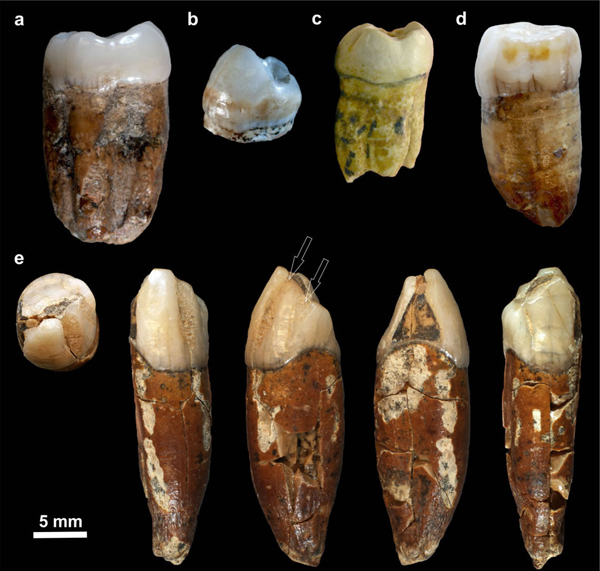


Fossils of Peking Man. [File photo]
Fossils of Peking Man are very rare, as most disappeared during World War II, so it is no surprise that scientists are excited by analysis published on a tooth from a 600,000 year old ancestor of modern man.
The latest issue of "Acta Anthropologica Sinica", featured the findings of Swedish and Chinese scientists.
According to Liu Wu from the Institute of Vertebrate Paleontology and Paleoanthropology, Chinese Academy of Sciences, the tooth in question is an upper right canine from a Peking Man.
The tooth was fully developed, indicating the individual was between 20 to 40 years old.
Age is revealed by counting dentine incremental layers, Martin Kundrat from the Evolutionary Biology Centre at Uppsala University, Sweden, said.
The tooth has two large chips, extending from the biting edge down toward the base of the crown.
"One of these chips has been partly smoothed by wear, showing that it was formed long before the death of the individual," he added. "It is possible that they were using their teeth as tools or they could bite some solid objects, such as nuts or animal bones."
Liu revealed that future research will see the extraction of residue from the tooth to identify the food the Peking Man ate.
The crown and root are smaller than other teeth found, Kundrat says, indicating Peking man could actually be a woman.
However, Liu said the tooth alone could not prove the gender of the individual.
Unexpected Find
For a long time after World War II, the only specimens of Peking Man fossils that survived the original excavation were three teeth at Uppsala University's collection. It was not until 2011 that Kundrat and Jan Ove R. Ebbestad, curator of the Museum of Evolution at the university, found the fourth tooth.
Kundrat discovered the tooth while looking through almost-forgotten expedition crates. About 40 crates shipped from China to Uppsala almost a century ago held vertebrate fossils.
Swiss paleontologist Carl Wiman had been in charge of identifying and describing the fossils but after his death in 1944, the direction of research changed, leaving the 40 crates unopened and forgotten.
On March 21, 2011, Kundrat and Ebbestad opened a crate that bore the letters ZKD, the acronym for Zhoukoudian, the Peking Man fossil site to find tooth fragments.
He sensed the importance of the discovery and contacted Liu Wu and Tong Haowen, also from the Chinese institute, to help them identify the tooth.
Immeasurable Loss
In the middle of 19th century, Western archeologists scoured the globe for evidence of our ancestors. In the early 20th century, they arrived in China.
In 1910s, when visiting a hill near the village of Zhoukoudian in southwest Beijing, Swedish geologist Johan Gunnar Andresson noticed some peculiar quartz fragments, which were not native to the site and resembled primitive stone tools.
Otto Zdansky from Uppsala University unearthed the first dental remains of Peking Man in 1921.
The second tooth was found among other vertebrate fossils in the crates that were shipped to Uppsala for research.
After that, Weng Wenhao, then director of the Geological Survey of China; Davidson Black, a Canadian paleoanthropologist and Anders Birger Bohlin, a fresh Uppsala graduate; then took over the excavation.
On Oct. 16, 1927, Bohlin recovered another tooth of the Peking Man from the same layer where Zdansky found his first specimen. Bohlin's specimen was described by Black and became the holotype of the new extinct hominid.
From 1928 to 1937 numerous remains of Peking Man were discovered including five skulls, and specimens from more than 40 individuals.
"But this enormous success dramatically turned into the biggest loss in the history of paleoanthropology," Kundrat says.
In 1941, the whole collection, including the holotype, disappeared just before it was due to be shipped to the United States for safekeeping.
Of all the specimens collected prior to the war, only the two teeth sent to Uppsala in 1924, had survived. However, many crates of Zhoukoudian material that had been shipped to Uppsala University in the 1920s remained unstudied, and these were eventually to yield further specimens: In 1951, Zdansky found a third tooth, a right lower fourth premolar, and in 2011, Kundrat found the fourth one.
"Theoretically more specimens of Peking Man could be possibly found in the crates. I will check the contents again," says Kundrat.
This tooth, he explained, is unique as it is one of the very first pieces of evidence proving the existence of the Peking Man.
Though excellent casts and descriptions of the original fossils still exist, Liu says, the original fossils would give so much insight into ancient humans.
 J-11 fighters in air exercise
J-11 fighters in air exercise Beauties dancing on the rings
Beauties dancing on the rings Attendants-to-be join Mr. & Miss Campus Contest
Attendants-to-be join Mr. & Miss Campus Contest Beijing's toughest anti-smoking law takes effect
Beijing's toughest anti-smoking law takes effect Family lives in cave for about 50 years in SW China
Family lives in cave for about 50 years in SW China PLA soldiers operating vehicle-mounted guns in drill
PLA soldiers operating vehicle-mounted guns in drill Blind carpenter in E China's Jiangxi
Blind carpenter in E China's Jiangxi China hosts overseas disaster relief exercise for the first time
China hosts overseas disaster relief exercise for the first time 20 pairs of twins who will become flight attendants in Sichuan
20 pairs of twins who will become flight attendants in Sichuan Obama is sowing discontent in S.China Sea
Obama is sowing discontent in S.China Sea Rescuers work through night to reach cruise ship survivors
Rescuers work through night to reach cruise ship survivors Driving through limbo
Driving through limbo Facing down MERS
Facing down MERSDay|Week